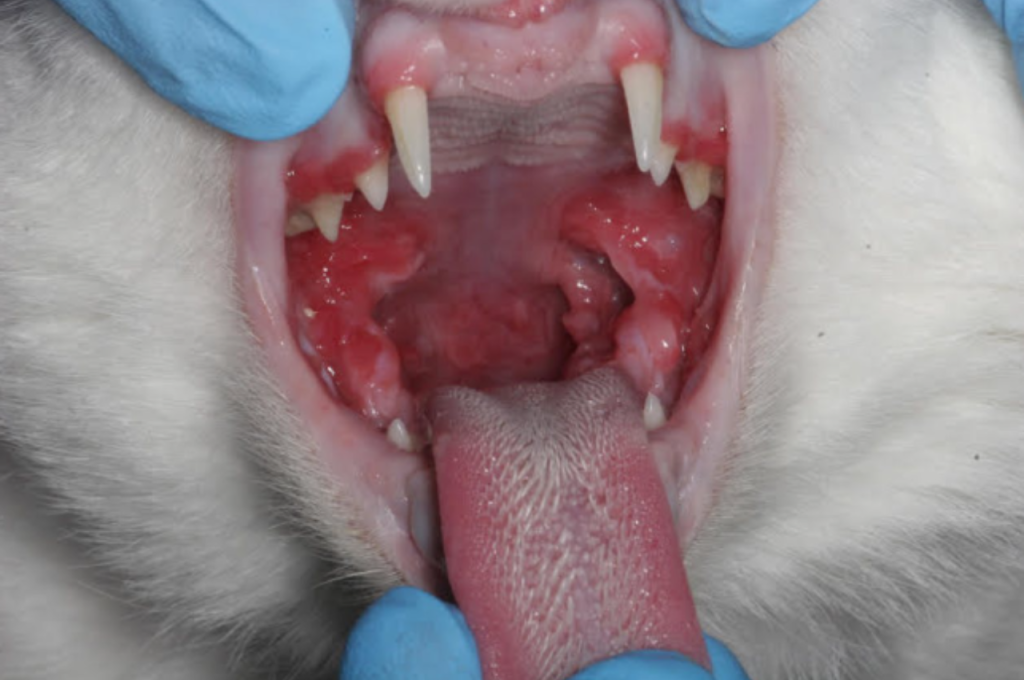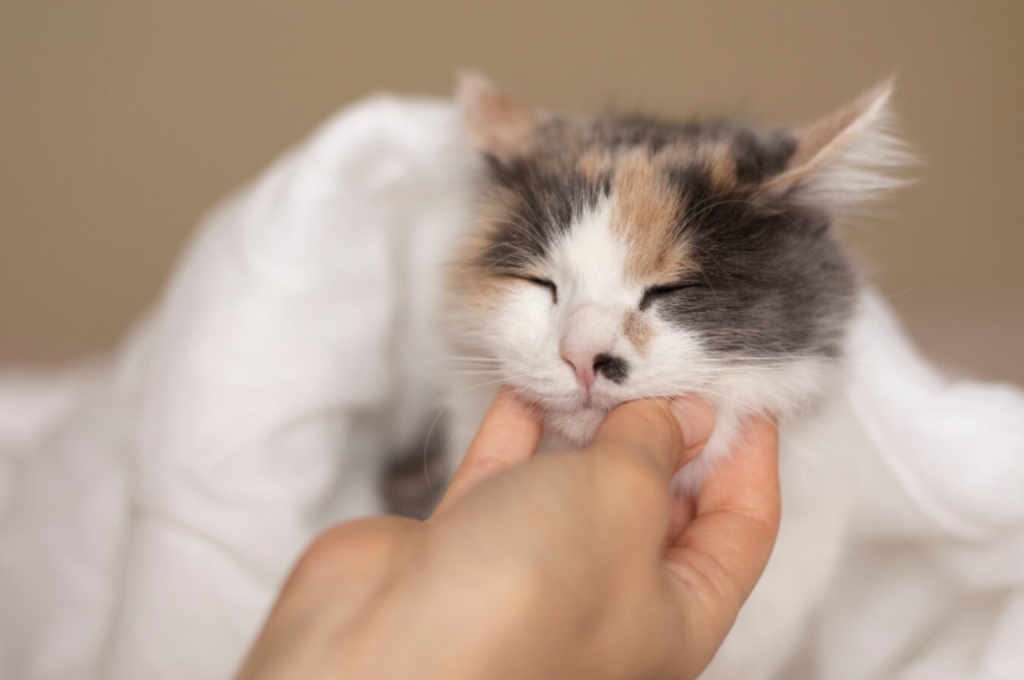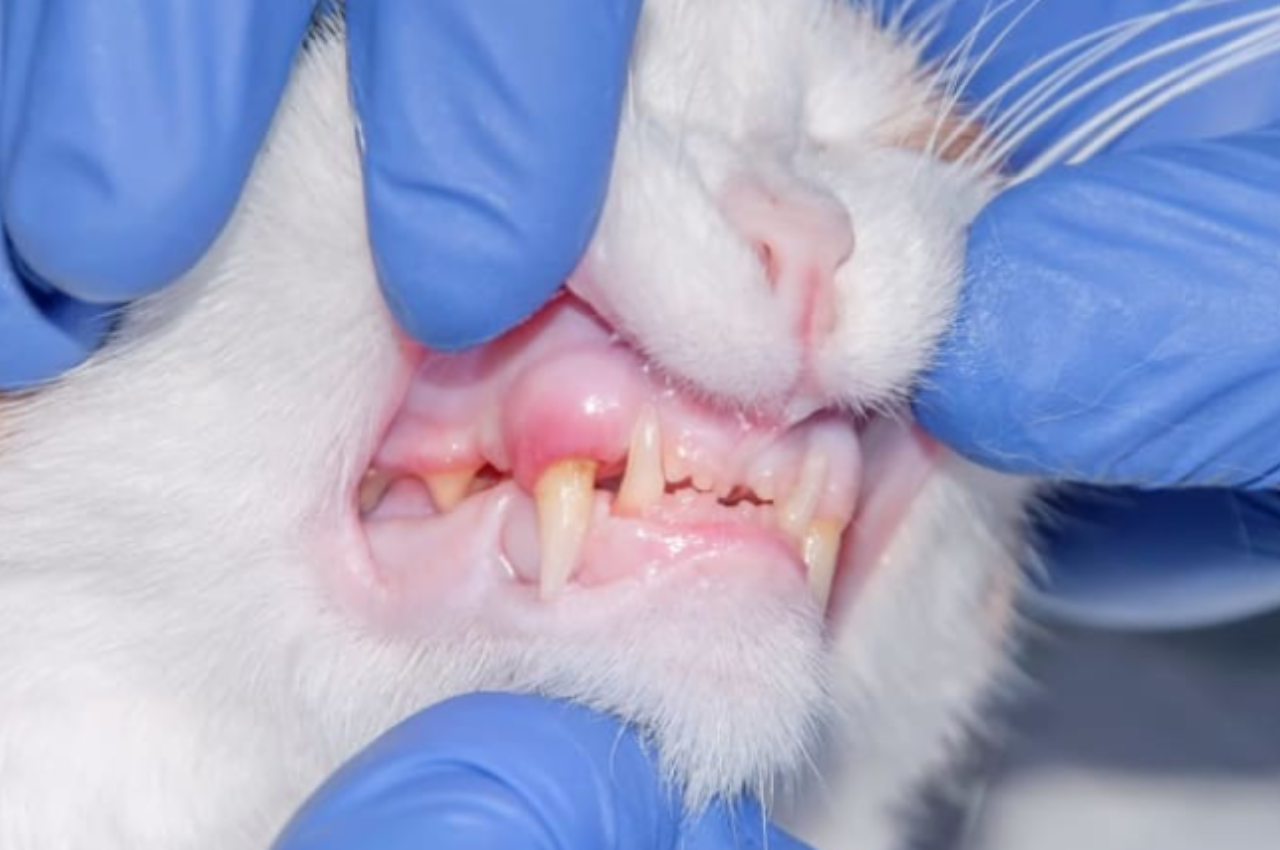Stomatitis in cats is an inflammation of the mouth tissues, causing pain and discomfort. This condition can lead to difficulty eating and drinking, as well as drooling and bad breath.
It is important to address stomatitis in cats promptly to alleviate their discomfort and prevent further complications. Stomatitis, also known as feline stomatitis or chronic gingivostomatitis, is a common oral disease in cats. It is characterized by severe inflammation and ulceration of the gums and other soft tissues in the mouth. While the exact cause of stomatitis is unknown, it is believed to be an immune-mediated condition, meaning the cat’s immune system overreacts to the presence of bacteria in the mouth. This exaggerated immune response leads to chronic inflammation and pain. Cats with stomatitis may show signs such as reluctance to eat, weight loss, excessive drooling, and bad breath. They may also have red, swollen gums, and ulcers in the mouth.
Stomatitis can significantly impact a cat’s quality of life, as the pain makes it difficult for them to eat and drink normally. If left untreated, stomatitis can lead to secondary infections, tooth loss, and even systemic health problems. Therefore, it is crucial to seek veterinary care if you suspect your cat has stomatitis. Treatment options may include dental cleanings, antibiotics, anti-inflammatory medications, immune-suppressing drugs, or in severe cases, extraction of some or all of the teeth. Stomatitis is a painful condition that affects the oral health of cats. By recognizing the signs early and seeking appropriate veterinary care, you can help your cat find relief and improve their overall well-being.
Introduction To Stomatitis In Cats
Stomatitis in cats is a painful oral inflammation that affects the gums, tongue, and other soft tissues in the mouth. It is a chronic condition that can lead to difficulty eating, weight loss, and other health problems. Treatment options include medication, surgery, and dental care.

If you have a furry feline friend, you know how important it is to keep them healthy and happy. Unfortunately, cats can sometimes develop oral health issues, one of which is stomatitis. Stomatitis is a common condition that affects cats, causing inflammation in their mouths and making it painful for them to eat and groom themselves.
What Stomatitis Means For Your Feline
Stomatitis, also known as feline chronic gingivostomatitis (FCGS), is a condition where the tissues in a cat’s mouth become inflamed, particularly the gums and the back of the throat. It is a chronic condition that can cause severe discomfort and pain for your furry friend. Stomatitis is often associated with a severe immune response to plaque and bacteria that accumulate on the teeth and gums.
When a cat has stomatitis, their immune system overreacts to the presence of bacteria, triggering inflammation in the mouth. This exaggerated response can lead to painful ulcers, red and swollen gums, and difficulty eating. The exact cause of stomatitis is still unknown, but factors such as genetics, dental hygiene, and viral infections may contribute to its development.
Common Symptoms
If you suspect your cat may have stomatitis, it’s essential to be aware of the common symptoms associated with this condition. These symptoms may include:
- Bad breath
- Excessive drooling
- Difficulty eating or loss of appetite
- Pawing at the mouth
- Weight loss
- Red, inflamed gums
- Oral ulcers or sores
- Reluctance to groom
If your cat exhibits any of these symptoms, it’s crucial to consult with your veterinarian for a proper diagnosis and treatment plan. Early detection and intervention can help alleviate your cat’s discomfort and prevent the condition from worsening.
Types Of Feline Stomatitis
Feline stomatitis is a painful and inflammatory condition affecting a cat’s mouth. This condition can be quite distressing for both the cat and the pet owner. There are two main types of feline stomatitis: lymphocytic plasmacytic stomatitis and eosinophilic stomatitis.
Lymphocytic Plasmacytic Stomatitis
Lymphocytic plasmacytic stomatitis, also known as LPS, is the most common form of feline stomatitis. It is characterized by severe inflammation of the gums, tongue, and throat. The immune system overreacts to plaque and tartar, leading to painful lesions and ulcers in the mouth.
Eosinophilic Stomatitis
Eosinophilic stomatitis is a less common but equally distressing form of feline stomatitis. This condition is characterized by an allergic reaction to a variety of factors, including food, bacteria, or environmental allergens. It often presents as severe inflammation and ulceration of the oral tissues.
Diagnosing Stomatitis In Cats
When it comes to diagnosing stomatitis in cats, a thorough evaluation by a veterinarian is essential.
Clinical Examination
Clinical examination includes checking the cat’s mouth for inflammation, redness, and ulcers.
Diagnostic Tests Used
Diagnostic tests like dental X-rays and oral swabs may be conducted to identify the extent of the condition.
Traditional Treatment Options
Stomatitis in cats is a painful oral disease that causes inflammation in the mouth. Traditional treatment options may include antibiotics, pain medication, and dental cleaning. It is important to seek veterinary care for proper diagnosis and treatment.
Cats suffering from stomatitis require various traditional treatment options to manage their condition effectively.
Medications Prescribed
Medications prescribed for stomatitis in cats include antibiotics, steroids, and immunosuppressants.
Surgical Interventions
Surgical interventions for stomatitis may involve full-mouth extractions or laser therapy to remove the affected tissue.
Home Care And Management
When it comes to home care and management of stomatitis in cats, there are key aspects to focus on, such as dietary adjustments and oral hygiene practices.
Dietary Adjustments
Certain dietary changes can help alleviate stomatitis symptoms in cats. Consider soft or wet food to make eating easier for your cat. Avoid hard kibbles that may further irritate the gums and opt for smaller, more frequent meals to reduce stress on the mouth.
Oral Hygiene Practices
Maintaining good oral hygiene is crucial for managing stomatitis in cats. Regular brushing can help prevent plaque buildup and reduce inflammation. Dental rinses and gels are also beneficial in promoting oral health and controlling bacterial growth.
Alternative Therapies And Supplements
Stomatitis in cats can be managed with alternative therapies and supplements to alleviate symptoms naturally. Integrating herbal remedies and vitamins into their diet can support oral health and reduce inflammation. By exploring holistic approaches, cat owners can provide relief and improve their furry friend’s well-being.

Alternative Therapies and Supplements Stomatitis in cats can be a painful and distressing condition, and while traditional veterinary treatments are often necessary, alternative therapies and supplements can play a valuable role in managing the symptoms and promoting healing. Natural remedies and supplements can help to reduce inflammation, support the immune system, and alleviate discomfort in cats suffering from stomatitis.
Natural Remedies
Natural remedies such as herbal and homeopathic preparations can be beneficial in managing stomatitis symptoms. Chamomile, calendula, and echinacea are known for their anti-inflammatory and immune-supporting properties. These natural remedies can be administered orally or topically to help soothe oral inflammation and promote healing.
Supplements To Consider
Several supplements can be considered to support the overall health and well-being of cats with stomatitis. Omega-3 fatty acids have anti-inflammatory properties and can help reduce oral inflammation. Probiotics can support gastrointestinal health and boost the immune system, while L-lysine may help reduce the severity and frequency of stomatitis flare-ups.
In addition to these supplements, vitamin E and vitamin C can also aid in reducing inflammation and promoting tissue repair. These supplements can be added to the cat’s diet or administered as directed by a veterinarian to ensure optimal therapeutic benefits. Using a holistic approach that includes alternative therapies and supplements can complement traditional veterinary treatments, helping to improve the overall well-being of cats suffering from stomatitis. By incorporating these natural remedies and supplements, cat owners can provide their feline companions with additional support in managing this challenging condition.
Prognosis And Quality Of Life
Stomatitis in cats is a painful oral condition causing inflammation and ulcers, affecting their quality of life. Prognosis varies but proper treatment and dental care can improve their comfort and overall well-being.
When it comes to stomatitis in cats, the prognosis and quality of life can vary depending on the severity of the condition and the effectiveness of the treatment. While stomatitis cannot be cured, managing the chronic condition and providing supportive care strategies can significantly improve a cat’s overall well-being.
Managing Chronic Conditions
Managing stomatitis in cats involves a combination of medical interventions and lifestyle adjustments. The primary goal is to reduce inflammation and pain in the mouth, allowing the cat to eat and groom comfortably. Here are some strategies that can help in managing this chronic condition:
- Medication: Your veterinarian may prescribe anti-inflammatory drugs or immune-suppressing medications to reduce the inflammation and control the immune response that triggers stomatitis.
- Dental Care: Regular dental cleanings and extractions of severely affected teeth may be necessary to remove the source of inflammation and prevent further complications.
- Dietary Modifications: Switching to soft or wet food can make it easier for cats with stomatitis to eat. Some cats may benefit from hypoallergenic or prescription diets that support oral health.
- Supplements: Certain supplements, such as omega-3 fatty acids or immune-boosting vitamins, may be recommended to support the cat’s overall health and reduce inflammation.
Supportive Care Strategies
In addition to medical interventions, providing supportive care can greatly enhance a cat’s quality of life when dealing with stomatitis. Here are some strategies to consider:
- Regular Monitoring: Frequent check-ups with the veterinarian are essential to monitor the cat’s condition, adjust treatment plans if necessary, and address any concerns promptly.
- Pain Management: Pain medications or local anesthetics can help alleviate discomfort associated with stomatitis. Your veterinarian will determine the appropriate pain management plan for your cat.
- Oral Hygiene: Regular brushing or rinsing of the cat’s teeth and gums can help reduce plaque buildup and control bacterial growth, minimizing the risk of infection.
- Stress Reduction: Creating a calm and stress-free environment for your cat can help boost their immune system and reduce the frequency and severity of stomatitis flare-ups.
By implementing these management strategies and providing ongoing care, cats with stomatitis can experience an improved quality of life, reduced pain, and better overall oral health. It’s important to work closely with your veterinarian to develop a personalized treatment plan that suits your cat’s individual needs. With proper care and attention, cats with stomatitis can lead happy and comfortable lives.
Preventing Stomatitis In Cats
Regular Dental Check-ups
Regular dental check-ups are crucial for preventing stomatitis in cats. Cats should have their teeth examined by a veterinarian at least once a year. This can help identify any dental issues early on, including the development of stomatitis. Early detection can lead to prompt treatment, preventing the condition from worsening.
Preventive Measures
There are several preventive measures that can be taken to reduce the risk of stomatitis in cats. Feeding a balanced diet that promotes dental health, such as one containing dental-friendly kibble, can help prevent plaque and tartar buildup. Regular brushing of the cat’s teeth can also contribute to maintaining good oral hygiene. Additionally, providing chew toys and treats designed to promote dental health can aid in preventing stomatitis.
When To Consult A Veterinarian
Stomatitis in cats is a painful inflammation of the mouth, gums, and throat. Symptoms include drooling, difficulty eating, and bad breath. If your cat is showing signs of stomatitis, it’s important to consult a veterinarian for proper diagnosis and treatment.
Recognizing Emergencies
If you notice your cat experiencing severe symptoms such as excessive drooling, reluctance to eat or drink, or bleeding from the mouth, it’s essential to seek immediate veterinary care. These signs could indicate a more serious underlying issue requiring prompt attention.
Routine Health Evaluations
Regular check-ups with a veterinarian are crucial in maintaining your cat’s oral health. During these appointments, the vet can identify any potential issues early on, provide preventive care, and offer guidance on maintaining good oral hygiene for your feline companion.
When to Consult a Veterinarian: If you notice your cat exhibiting symptoms such as excessive drooling, reluctance to eat or drink, or bleeding from the mouth, it’s essential to seek immediate veterinary care. These signs could indicate a more serious underlying issue requiring prompt attention. Regular check-ups with a veterinarian are crucial in maintaining your cat’s oral health. During these appointments, the vet can identify any potential issues early on, provide preventive care, and offer guidance on maintaining good oral hygiene for your feline companion.
Real Stories: Feline Stomatitis Cases
When it comes to understanding stomatitis in cats, real stories from feline owners who have dealt with this condition can provide valuable insights into the recovery journeys and the impact it has on the lives of both cats and their owners. These owner testimonials shed light on the challenges faced, treatment options explored, and the eventual road to recovery.

Recovery Journeys
The recovery journey for cats with stomatitis can vary from case to case. Some cats may respond well to treatments, while others may require more intensive interventions. The following are a few examples of feline stomatitis cases and their inspiring recovery journeys:
- Case 1: Lucky’s Triumph Over Stomatitis
Lucky, a 4-year-old tabby, was diagnosed with severe stomatitis that caused him significant discomfort and difficulty eating. His owner, Sarah, tried various treatments, including antibiotics and steroids, but saw limited improvement.
After consulting with a veterinary specialist, Lucky underwent a dental extraction procedure to remove the affected teeth. Slowly but surely, Lucky’s condition improved, and he regained his appetite. Today, Lucky enjoys a happy, pain-free life. - Case 2: Bella’s Long Road to Recovery
Bella, a 6-year-old Siamese mix, was diagnosed with advanced stomatitis that affected her overall health. Her owner, John, opted for a multi-faceted approach to treatment, which included dental cleanings, immunosuppressive therapy, and regular oral hygiene care.
While Bella’s recovery was gradual, her condition significantly improved over time. With consistent care and support from John, Bella now experiences fewer flare-ups and can enjoy her favorite foods again.
Owner Testimonials
Here are some testimonials from owners who have witnessed the impact of stomatitis on their beloved feline companions:
- Testimonial 1: Jane’s Journey with Max
“Max, my 8-year-old Maine Coon, developed stomatitis, and it was heartbreaking to see him in pain. We tried different treatments, but it wasn’t until we opted for a full-mouth extraction that Max finally found relief. I’m grateful for the expertise of our veterinarian and the positive outcome.” - Testimonial 2: Mark’s Experience with Luna
“Luna, my 3-year-old Ragdoll, was diagnosed with stomatitis, and it was a challenging time for both of us. We explored various treatment options, including laser therapy and immunosuppressive medications. It took time, but Luna’s condition improved, and she’s now back to her playful self. It’s been a journey of patience and determination.”
Conclusion
Understanding stomatitis in cats is crucial for pet owners. Recognizing the signs and seeking prompt veterinary care can improve the cat’s quality of life. By implementing preventive measures and proper treatment, pet owners can help their feline companions manage this painful condition.
Stay informed and proactive to support your cat’s health.
